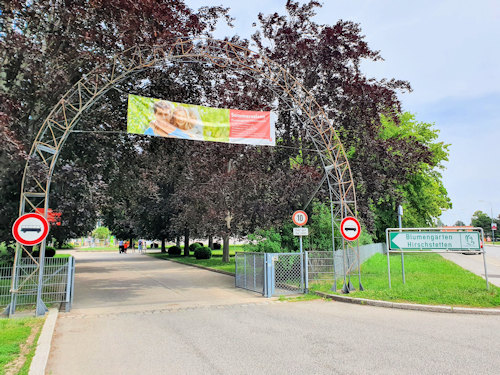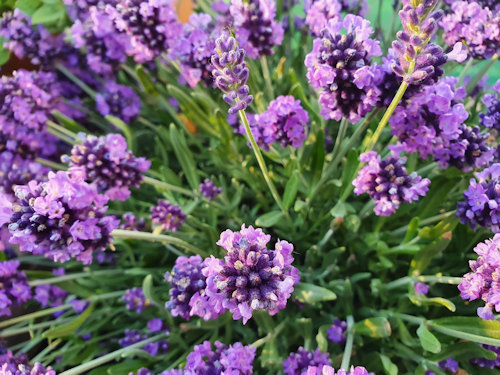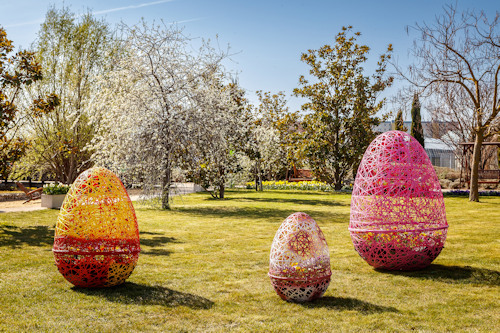
An undiscovered treat lies some way from Vienna’s tourist-filled centre. The Hirschstetten Botanical Gardens take you on a flower-filled journey full of colour, infotainment, and a surprise or three.
- Amazing variety of themed botanical areas
- Animals, too (many free-roaming)
- Good for kids (including a maze and playgrounds)
- Small café and plenty of picnic areas
- Free entry
- Limited access in the colder months
- Look for the Easter & Christmas events
- Book a guided walking tour* for your visit to Vienna
- See also:
Blumengärten Hirschstetten

(The deceptively unassuming main entrance to Hirschstetten)
A fiendish trivia question might ask where you can find a French lavender field, an English rose garden, an Austrian vineyard, Egyptian fruit bats, chili pepper and banana plants, and a statue of the elephant-headed Hindu God Ganesha.
The answer is a quiet municipal plant nursery facility in the eastern suburbs of Vienna.
Whereby nursery is no longer really the case.
Hirschstetten Botanical Gardens does still serve its traditional purpose as one of the sources of flowers and shrubs for Vienna’s extensive programme of planting in city parks and similar.
But each year – as the name suggests – sees it focus more on more on its own role as a recreational resource for animal and plant-loving locals. With many surprises in store for its visitors.
Travel the botanical globe

(Lavender from my garden)
The gardens feature numerous themed areas, but if you’re expecting “alpine meadow” and “woodland shrubs”, think again.
You might find yourself dodging the bees among swathes of lavender.
Or contemplating tree ferns in a prehistoric garden.
Or listening to the drip of water in the 700m2 tropical palm house.
Or smelling the roses in an English garden.
Or exploring model solutions for terrace, senior, or kitchen gardens.
Or counting water lilies on a small lake.
Or viewing the yuccas and amaranth in the Mexican garden.
And much more…
Animals and entertainment

(Expect to see European ground squirrels, who don’t keep to their own enclosures)
A fair bit of animal life appears, too.
Ponds and other water features pop up across the gardens, often filled with enough frogs, newts and toads to delight the sternest Shakespearean witch.
Some of the dragonflies we saw were more dragon than flies, given their size. And several butterfly species flitted past on our spring visit including (I think) a swallowtail.
Dedicated enclosures contain wild cats, tortoises and owls, for example. Old farmhouse buildings have rabbits, chickens, sheep, and goats. Look inside a bee hive or visit an insect hotel. That tropical palm house has suitable mammals and reptiles inside, too.
Lose yourself (figuratively and literally) in the field maple maze. Or put your feet up on a small beach beside the lake. And the kids can while away the time clambering around slides, swings and climbing frames.
You can even get married at Hirschstetten.
By now you should have some idea of the diversity within the gardens, even though the area really isn’t that large (around 6 hectares or 15 acres).

(Easter decorations just after the spring opening; press photo © Stadt Wien/Houdek)
Tickets & visitor tips
Remarkably, entrance to Hirschstetten is free.
Be careful with opening times and days, though. Use Google translate and the official visitor information page for details.
For example, the main gardens, palm house and animal areas only open principally between March 18th and October 19th in 2025. Note also that almost all information displays were German-only on my last visit (this is a part of Vienna undiscovered by tourists).
- A small self-service café booth usually sells meals, snacks, cold drinks, beer and wine with covered areas to sit in
- Alternatively, bring your own food for the designated picnic areas featuring tables and seats
- Hirschstetten hosts various events through the year. Three of particular note:
- The International Orchid Show
- Easter in Hirschstetten with a seasonal market
- A Christmas exhibition and market
Both the orchid and Christmas events mirror the surrounds in providing rather lovely botanical and floral sights. Especially the Christmas one, which has a whole glasshouse turned over to themed ornamental displays.
How to get to Hirschstetten
Sadly, unlike most of Vienna’s visitor attractions, Hirschstetten cannot be described as central. Equally, like most places in the city, public transport takes you there relatively quickly.
A combination of subway and bus or tram works best, though the location is a little off the beaten track.
Subway and tram
Use the U1 subway line to reach Kagraner Platz (the U1 leaves from, for example, Stephansplatz in the centre). Then catch the 26 tram to the Oberfeldgasse/Spargelfeldstr. stop. This drops you close to a rear/side entrance to the botanical gardens.
Subway and bus
Jump on the U2 subway to Hardeggasse station, then exit to the northeast and look for the bus stop over on the other side of Langobardenstraße. Take the 95A bus going west. Be careful: don’t get off at the bus stop marked Hirschstetten Ort but go on one more stop to Blumengarten Hirschstetten.
The bus line is not particularly frequent by Vienna standards, but you shouldn’t have to wait too long.
Address: Blumengärten Hirschstetten, Quadenstraße 15, 1220 Vienna | Website